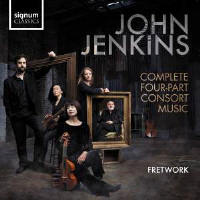Texte paru dans: / Appeared in: |
|
|
Outil de traduction ~ (Très approximatif) |
|
|
Reviewer: William
J. Gatens
John Jenkins (1592-1678) was
one of the most celebrated English composers of consort music in his day.
Richard Boothby, bass violist with the consort Fretwork, observes in the
notes here that amateur players continue to love his consort music for its
melodic richness, harmonic sophistication, independence of parts, and the
composer’s insider knowledge of the capabilities of the instruments. Jenkins
was born during the reign of Elizabeth I and died 86 years later when
Charles II occupied the throne. He flourished at a time when the techniques
of Renaissance polyphony were giving way to the baroque style. In some of
his later works violins begin to supplant viols in ensemble music and
keyboard continuo writing makes an appearance, but the music never
completely loses the English consort style. As Boothby points out, Jenkins’s
music is difficult to date, but it is likely that these pieces for four
viols (treble, two tenor, and bass) date from early in his long career.
Judging from this music, Jenkins sought to delight with elegance rather than astound with audacity. By the same token, no one could dismiss his music as blandly correct. It abounds with intricate counterpoint, lively rhythms, and flowing melodic lines. Apart from the two somber pavans, the four-part consort music is predominantly cheerful. Sometimes, as in the Fantasia 17, Jenkins achieves a peaceful serenity in music that unfolds in sustained and slow-moving lines.
The performances here are
understated but remarkably sensitive. The string tone is both warm and
clear. Fretwork is one of the leading viol consorts currently active. The
flawless ensemble and intonation heard here are a given for performers of
that stature. As I have observed on previous occasions, consort music is
intended mainly for the delectation of the performers rather than the
entertainment of an audience. As listeners it is as if we are privileged to
overhear a witty and eloquent conversation among friends. These performances
are exemplary for their conversational quality. Readers interested in this
repertory may wish to consider the recording of Jenkins’s sixpart consort
music by Phantasm (Avie 2099; J/F 2007), another first-rate viol consort who
have also issued an outstanding recording of works by William Lawes. Readers
looking for a cross-section of Jenkins’s consort works should consider
recordings by Ensemble Jerome Hantai (Naive 8895; M/A 2005) and the Consort
of Musicke (Explore 10; J/F 2007). | |
|
|
|
|
Cliquez l'un ou l'autre
bouton pour découvrir bien d'autres critiques de CD |
|




